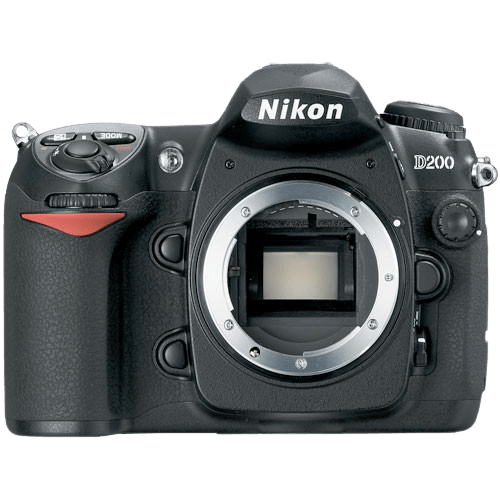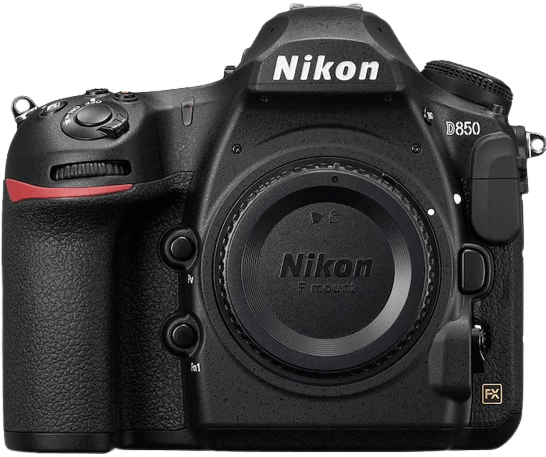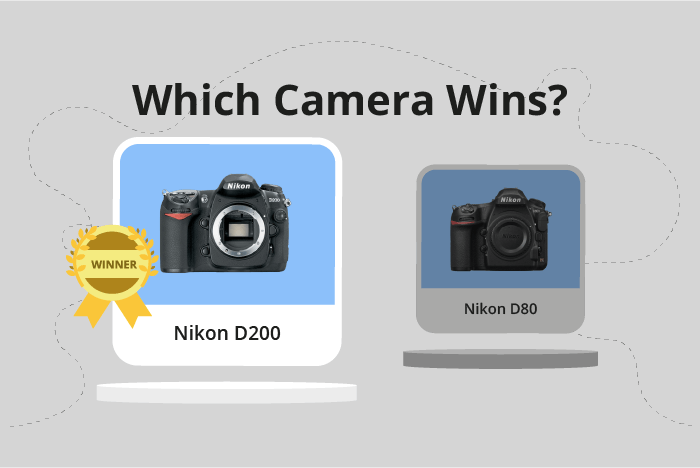Nikon D200 vs D80 Comparison
Nikon D200

Nikon D80

The Nikon D200 outperforms the Nikon D80 with a score of 37/100 compared to 34/100. Both cameras are DSLR models, announced in 2005 and 2006, respectively. They share similarities in launch price, with the D200 priced at $1000 and the D80 at $730. However, the D200 has a larger body (147 x 113 x 74mm) and weighs more (920g / 2.03lbs) than the D80 (132 x 103 x 77mm and 668g / 1.47lbs).
The Nikon D200’s higher score indicates it offers better overall performance. On the other hand, the Nikon D80’s smaller size and lighter weight make it more portable and convenient for some users. Considering these factors, the Nikon D200 is the better choice for those seeking a more robust camera, while the Nikon D80 is suitable for those prioritizing portability.
Nikon D200 vs D80 Overview and Optics
The Nikon D200 outperforms the Nikon D80 in optics with a score of 41/100 compared to the D80’s 39/100. Both cameras share several specifications, including a 10-megapixel CCD sensor, Nikon Image processing engine, APS-C sensor size, Nikon F DX lens mount, and no image stabilization.
The D200’s superiority comes from its faster shooting speed and higher DXOMARK score for the sensor. The D200 has a shooting speed of 5 frames per second (fps) while the D80 only manages 3 fps. This difference allows the D200 to capture fast-moving subjects more effectively. Additionally, the D200’s sensor scores a 64 on the DXOMARK scale, which is three points higher than the D80’s score of 61. This gap translates to better overall image quality and performance in the D200.
On the other hand, the D80 does not have any particular advantages over the D200 in terms of optics. Both cameras share the same megapixel count, sensor type, processor, sensor size, lens mount, and lack of image stabilization. The D80’s lower score is due to its slower shooting speed and lower DXOMARK score for the sensor.
Therefore, the Nikon D200 is the better choice for photographers seeking superior optics performance. Its faster shooting speed and higher DXOMARK sensor score contribute to its edge over the Nikon D80. Meanwhile, the D80 does not offer any advantages in this aspect, making the D200 the clear winner in the optics comparison.
Nikon D200 vs D80 Video Performance
When considering the video capabilities of the Nikon D200 and Nikon D80, it is important to note that neither camera possesses video functionality. As a result, there is no video score to compare between the two models. The lack of video capabilities does not directly influence the overall quality of the cameras, but it is a factor to consider when choosing between them.
Nikon D200 vs D80 Features and Benefits
The Nikon D200 outperforms the Nikon D80 with a feature score of 30/100 compared to the D80’s 17/100. Both cameras share several specifications, such as a 2.5-inch screen size and a screen resolution of 230,000 dots. Neither camera comes with a touchscreen or flip screen. Also, both lack GPS and Bluetooth capabilities.
The D200 surpasses the D80 due to its superior features. Although both cameras have the same screen size and resolution, the D200 offers more advanced options that contribute to its higher score. The exact specifications that make the D200 better are not provided, but it is clear that the D200 offers a better user experience.
On the other hand, the Nikon D80 does have one advantage over the D200: built-in WiFi. This feature allows users to easily transfer photos and videos to other devices, such as smartphones and computers. Despite this advantage, the D80’s overall features score is still lower than the D200.
To sum up, the Nikon D200 is a better camera than the Nikon D80, as evidenced by its higher feature score. Both cameras share several specifications, but the D200 excels with additional features that enhance its user experience. The D80’s only advantage is its built-in WiFi, which is not enough to surpass the D200’s overall superiority.
Nikon D200 vs D80 Storage and Battery
The Nikon D80 outperforms the Nikon D200 in storage and battery, scoring 53/100 compared to the D200’s 35/100. Both cameras have a single memory card slot, and neither offers USB charging. However, the D80 accepts SD and SDHC memory cards, while the D200 only supports Compact Flash (Type I or II).
The D80’s advantage becomes more evident in its battery life, lasting for an impressive 2700 shots compared to the D200’s 800 shots. Both cameras use the same battery type, the EN-EL3e. The D200’s lower battery life is its main drawback in this comparison.
In terms of storage and battery, the Nikon D80 is the superior choice due to its longer battery life and compatibility with more common memory cards. The D200 falls short in these aspects, making the D80 a more practical option for extended use and convenience.
Nikon D200 vs D80 – Our Verdict
Are you still undecided about which camera is right for you? Have a look at these popular comparisons that feature the Nikon D200 or the Nikon D80:

